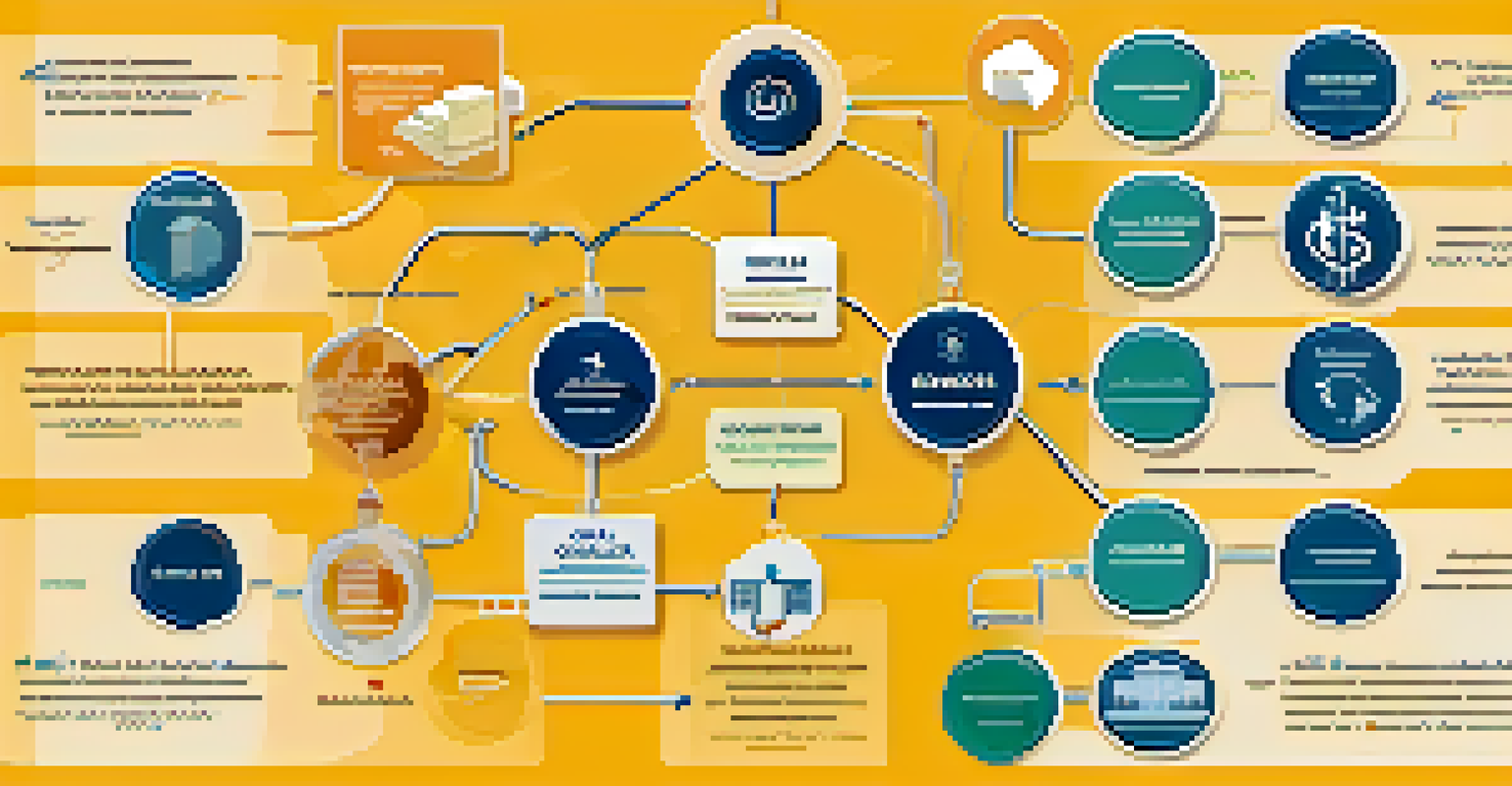Innovative Financing Models for Impact Investing

Understanding Impact Investing: A Brief Overview
Impact investing stands at the crossroads of finance and philanthropy, aiming to generate positive social and environmental outcomes alongside financial returns. Unlike traditional investing, which focuses solely on profit, impact investing seeks to address pressing global issues, such as poverty, climate change, and health disparities. By directing capital towards projects that promote sustainability and social justice, investors can make a meaningful difference in communities around the world.
Impact investing is not just about making a profit; it’s about making a difference.
The appeal of impact investing lies in its dual purpose; it allows investors to align their financial goals with their values. For instance, an investor passionate about renewable energy can support solar projects that not only yield returns but also contribute to a cleaner planet. This unique blend of profit and purpose has led to a surge in interest from both individual and institutional investors in recent years.
As we explore innovative financing models, it's essential to recognize how they can enhance the effectiveness of impact investing. By leveraging creative financial strategies, we can unlock more resources for projects that drive social change. This article will delve into various innovative approaches that are reshaping the landscape of impact investing.
Blended Finance: A Game-Changer for Impact Projects
Blended finance combines public, philanthropic, and private capital to address funding gaps in impact investments. This approach allows different funding sources to work together, thus mitigating risks and enhancing the viability of projects. For example, a philanthropic organization may provide initial funding to de-risk a project, attracting private investors to join in later stages with the confidence that their investment is more secure.

One of the key benefits of blended finance is its ability to mobilize greater resources for social good. By pooling different types of capital, projects can scale more rapidly and reach underserved populations. For instance, blended finance has been pivotal in funding clean water initiatives in developing countries, where traditional financing methods may have fallen short.
Impact Investing Combines Profit and Purpose
Impact investing aims to generate positive social and environmental outcomes alongside financial returns by addressing global issues like poverty and climate change.
Moreover, blended finance creates a sustainable ecosystem where various stakeholders collaborate towards common objectives. This model not only catalyzes investment in high-impact areas but also fosters innovation by encouraging new ideas and solutions that can be tested and scaled.
Social Impact Bonds: Linking Outcomes to Investment
Social impact bonds (SIBs) are a fascinating financial instrument that ties the return on investment directly to the success of social programs. In a typical SIB arrangement, private investors provide upfront capital to fund social initiatives, such as education or healthcare. If the project meets predetermined success metrics, the government or another entity repays the investors with interest, creating a win-win situation.
The future is not something we enter. The future is something we create.
This model shifts the financial risk away from the government and onto private investors, encouraging innovation and accountability in delivering social outcomes. An example of this is the Peterborough SIB in the UK, which aimed to reduce recidivism rates among former prisoners. Its success led to significant savings for the government and improved lives for participants, showcasing the potential of SIBs.
However, measuring outcomes can be complex, and defining success metrics requires careful planning and collaboration among stakeholders. Despite these challenges, SIBs represent an innovative approach to funding social programs, demonstrating how financial mechanisms can drive positive change.
Crowdfunding: Engaging Communities for Impact
Crowdfunding has emerged as a powerful tool for impact investing, allowing individuals to contribute small amounts of money towards projects that resonate with them. Platforms like Kickstarter and Indiegogo have paved the way for entrepreneurs and non-profits to showcase their initiatives, attracting support from a broad audience. This democratization of funding not only empowers communities but also fosters a sense of ownership among contributors.
One notable example of crowdfunding for impact is the rise of community solar projects, where local residents can invest in renewable energy solutions. By pooling their resources, they can fund solar installations that benefit the entire community, reducing energy costs and promoting sustainability. This model exemplifies how crowdfunding can harness collective efforts to drive significant social and environmental change.
Blended Finance Mobilizes Resources
Blended finance leverages public, philanthropic, and private capital to address funding gaps and enhance the viability of social projects.
Moreover, crowdfunding allows for greater transparency and engagement, as backers can see the direct impact of their contributions. This not only builds trust but also motivates investors to support future initiatives, creating a cycle of continuous support for impactful projects.
Pay-for-Success Models: Incentivizing Positive Outcomes
Pay-for-success models are innovative financing strategies that link funding to the achievement of specific social outcomes. In this model, investors provide upfront capital for social programs, and returns are contingent upon the program's success in meeting agreed-upon benchmarks. This approach shifts the focus from inputs to outcomes, incentivizing efficiency and effectiveness in program delivery.
One of the most significant advantages of pay-for-success models is that they encourage collaboration among various stakeholders, including governments, non-profits, and private investors. For example, in a pay-for-success initiative aimed at reducing homelessness, funding would be tied to measurable reductions in the homeless population, creating a shared incentive for all parties involved.
While promising, implementing pay-for-success models requires careful planning and clear metrics to evaluate success. However, when executed well, these models can drive significant social impact and ensure that resources are allocated effectively, ultimately benefiting communities in need.
Impact Investment Funds: Pooling Resources for Change
Impact investment funds are designed to pool capital from various investors to support projects that yield both financial returns and social impact. These funds often focus on specific sectors, such as affordable housing, renewable energy, or healthcare, enabling investors to align their portfolios with their values. By collectively investing in high-impact projects, these funds can amplify financial resources and maximize social benefits.
An example of a successful impact investment fund is the Blue Horizon Fund, which focuses on sustainable food systems. By investing in companies that prioritize ethical sourcing and environmental sustainability, the fund demonstrates how targeted investments can drive change within specific industries. This approach not only delivers returns for investors but also promotes responsible practices across sectors.
Technology Enhances Impact Investing
Technological innovations, such as blockchain and digital platforms, are revolutionizing impact investing by increasing transparency and accessibility for investors.
Furthermore, impact investment funds often provide additional support beyond capital, such as mentorship and strategic guidance to portfolio companies. This holistic approach not only enhances the likelihood of success for individual projects but also fosters a community of like-minded investors committed to driving meaningful change.
The Role of Technology in Innovative Financing Models
Technology is revolutionizing the way we approach impact investing, providing new tools and platforms that enhance transparency, accessibility, and engagement. Fintech innovations, such as blockchain, can streamline the investment process, reduce costs, and increase trust among stakeholders. For instance, blockchain technology allows for secure and transparent tracking of investments, ensuring that funds are used as intended.
Moreover, digital platforms have made it easier for individuals to participate in impact investing, breaking down traditional barriers that often excluded smaller investors. Crowdfunding platforms, for example, enable anyone to invest in social enterprises, democratizing access to capital and fostering a more inclusive investment landscape. This shift not only expands the pool of potential investors but also encourages more diverse projects to emerge.

As technology continues to evolve, it will play an increasingly vital role in shaping innovative financing models for impact investing. By embracing these advancements, investors and organizations can unlock new opportunities for collaboration and maximize the positive impact of their investments.
Conclusion: The Future of Impact Investing is Bright
As we’ve seen, innovative financing models are reshaping the landscape of impact investing, unlocking new opportunities for positive change. From blended finance to crowdfunding, these approaches not only mobilize capital but also foster collaboration among diverse stakeholders. This shift towards more dynamic and inclusive financing methods has the potential to drive significant social and environmental outcomes.
Looking ahead, the future of impact investing appears promising. As more investors recognize the importance of aligning their financial goals with their values, we can expect an increase in demand for innovative financing solutions that deliver measurable impact. The growing awareness of global challenges, coupled with the rise of technology, will undoubtedly pave the way for even more creativity in financing models.
Ultimately, the continued evolution of impact investing will require collaboration, transparency, and a shared commitment to driving positive change. By embracing innovative financing models, we can collectively work towards a better future for all, ensuring that capital is directed towards initiatives that truly make a difference.